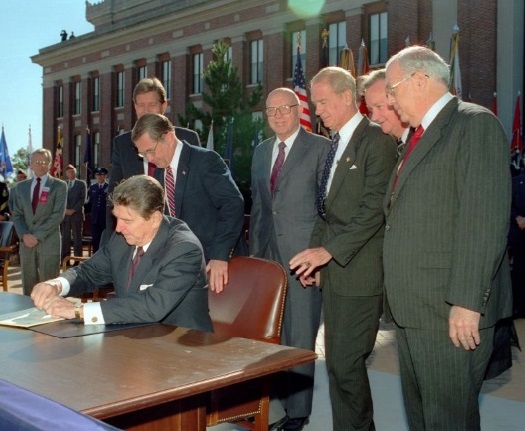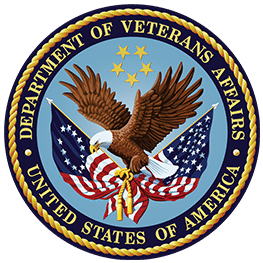
On the eve of Veterans Day in 1987, President Ronald W. Reagan delivered a surprise announcement to the leaders of the Veterans organizations and members of the Congressional Veterans Affairs Committees he had summoned to the Cabinet Room. He declared he would support legislation elevating the Veterans Administration to a cabinet department. His decision to back the creation of the Department of Veterans Affairs caught his senior advisors equally off-guard. Although a bipartisan bill in the House (H.R. 3471) had attracted 274 cosponsors, Chief of Staff Howard H. Baker, Jr., and other White House officials uniformly opposed the measure. Reagan, however, rejected their counsel. He had campaigned in 1980 on a promise to shrink the size of the federal government, but he was a Veteran himself, having served stateside in the military during World War II. “This is a personal decision that I have thought about for some time,” he explained to the group assembled in the Cabinet Room. Noting that the population of Veterans had increased sixfold since the establishment of the Veterans Administration in 1930, he said “Veterans have always had a strong voice in our government. It’s time to give them the recognition they so rightly deserve.”
Previous attempts to get legislation through Congress raising the VA to cabinet-level status had failed over the decades. The most recent effort, a Senate bill (S. 533) introduced by Army Veteran Strom Thurmond (R-SC) in February 1987, stalled despite drawing 44 Democratic and 28 Republican cosponsors. Thurmond faced resistance within his own party from Republicans who opposed expanding the federal bureaucracy. Reagan’s endorsement of the proposal, however, changed the political calculus. The House bill, put forward by Representative Jack B. Brooks, a Democrat from Texas, on October 13, 1987, sailed through the lower chamber a week after the president’s announcement by a 399-17 vote.

Passage in the Senate took longer. Supporters of the legislation tried to allay concerns about its impact by noting that it would result in more of an internal reorganization of the existing VA rather than any significant increase in the agency’s size, budget, or scope of authority. The Congressional Budget Office estimated that the cost would be a modest $33 million over five years, with most of the money going to the changing of signs at VA facilities. On July 12, 1988, the Senate voted 84-11 to approve an amended version of the bill. Another three months would pass as the two chambers ironed out their differences over the Senate’s changes and a companion bill reforming the appeals process. On October 21, the Department of Veterans Affairs Act finally reached the president for his signature.
The White House held the bill-signing ceremony four days later at Fort McNair in Washington, D.C., before an audience of U.S. military and government officials, Veterans, and other guests and dignitaries. The ceremony also doubled as a commemoration of the fifth anniversary of the invasion of Grenada. In his speech, Reagan paid tribute to the courage, resourcefulness, and sacrifice of the service members and Veterans who had fought to uphold the nation’s commitment to freedom around the world. After signing the bill into law, he also reflected on the significance of the legislation: “This bill gives those who have borne America’s battles, who have defended the borders of freedom, who’ve protected our Nation’s security in war and in peace, it gives them what they’ve deserved for so long – a seat at the table in our national affairs.” With the stroke of his pen, he raised the Veterans Administration to cabinet rank and turned it into the Department of Veterans Affairs, the fourteenth department within the executive branch and the second largest next to the Department of Defense.
Congress delayed implementation of the law until after the 1988 election to reserve the right of appointing the first VA Secretary to the incoming president. On January 20, 1989, the day he was inaugurated as the 41st president of the United States, George H. W. Bush named Edward J. Derwinski, a World War II Veteran, twelve-term Congressman, and final head of the Veterans Administration, to lead the department. The Senate confirmed his nomination without a dissenting vote. The law itself officially took effect on March 15, 1989. In a nod to tradition, the Department of Veterans Affairs continued to go by the initialism VA, as that designation had been used by Veterans and others for nearly six decades. However, the agency did replace the Veterans Administration seal with a new design selected from more than 150 entries submitted by employees in a VA-wide competition. The winning entry came from David A. Gregory, a medical media production specialist at the Indianapolis VA Medical Center.
View the video of President Ronald Regan’s remarks at Fort McNair on October 25, 1988, and watch as he signs the Department of Veterans Affairs Act (Public Law 100-527). The signing is at the 17:30 mark.
By Barbara Matos, Executive Assistant, Office of Procurement Policy, Systems and Oversight, and Jeffrey Seiken, Ph.D., Historian, Veterans Benefits Administration
Share this story
Related Stories

History of VA in 100 Objects
Object 96: Postcard of Veterans Vocational School
In 1918, the government created the first nationwide vocational training system to help disabled Veterans acquire new occupational skills and find meaningful work. Over the next 10 years, more than 100,000 Veterans completed training programs in every field from agriculture and manufacturing to business and photography.

History of VA in 100 Objects
Object 95: 1840 Census of Pensioners
In a first, the 1840 census collected data on Veterans and widows receiving a pension from the federal government. The government published its findings in a stand-alone volume titled “A Census of Pensioners for Revolutionary or Military Services.”

History of VA in 100 Objects
Object 94: Southern Branch of the National Home
The Southern Branch of the National Home for Disabled Volunteer Soldiers opened in Hampton, Virginia, in late 1870. The circumstances surrounding the purchase of the property, however, prompted an investigation into the first president of the National Home’s Board of Managers, Benjamin Butler.


